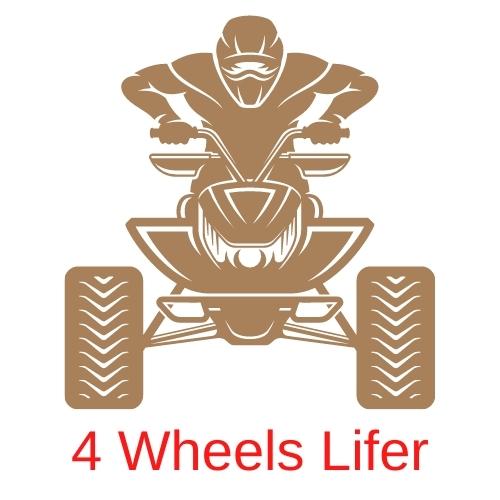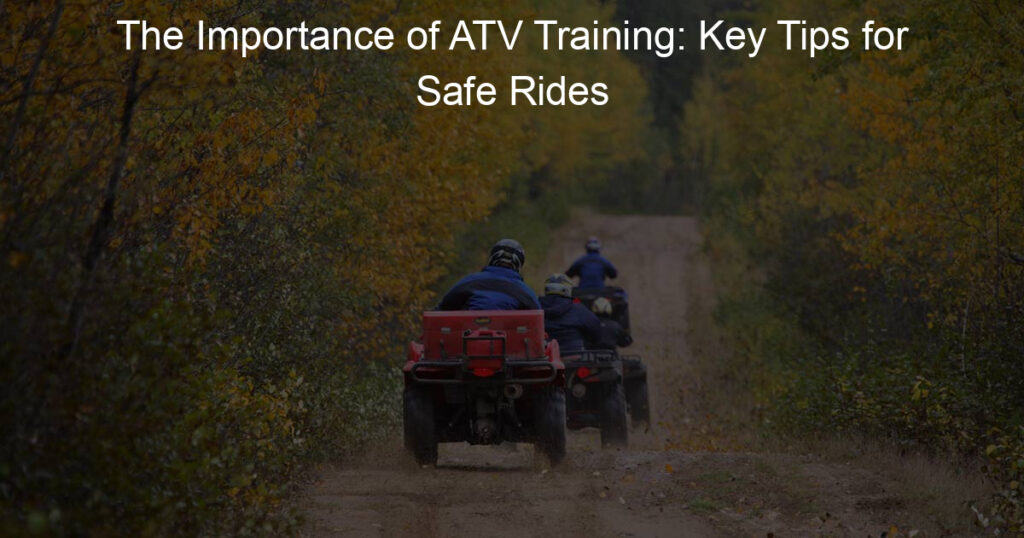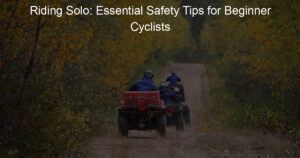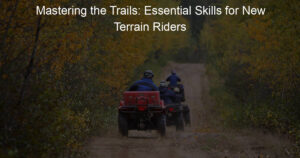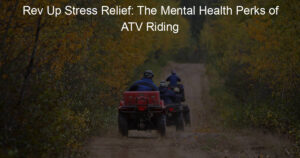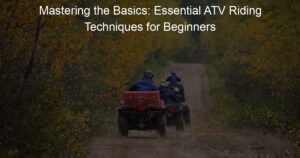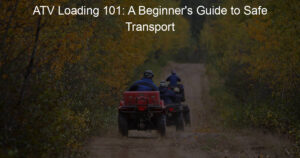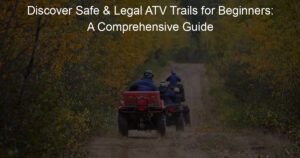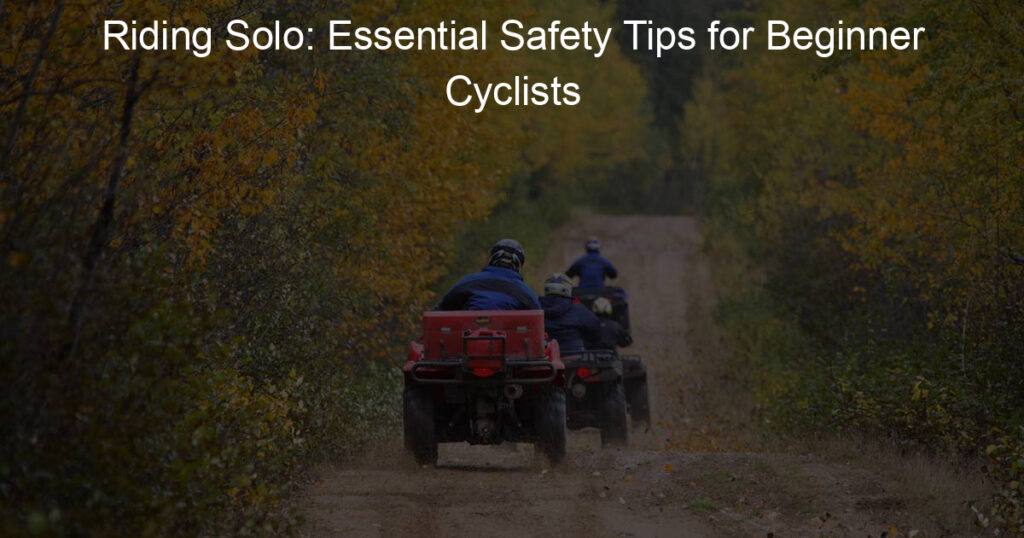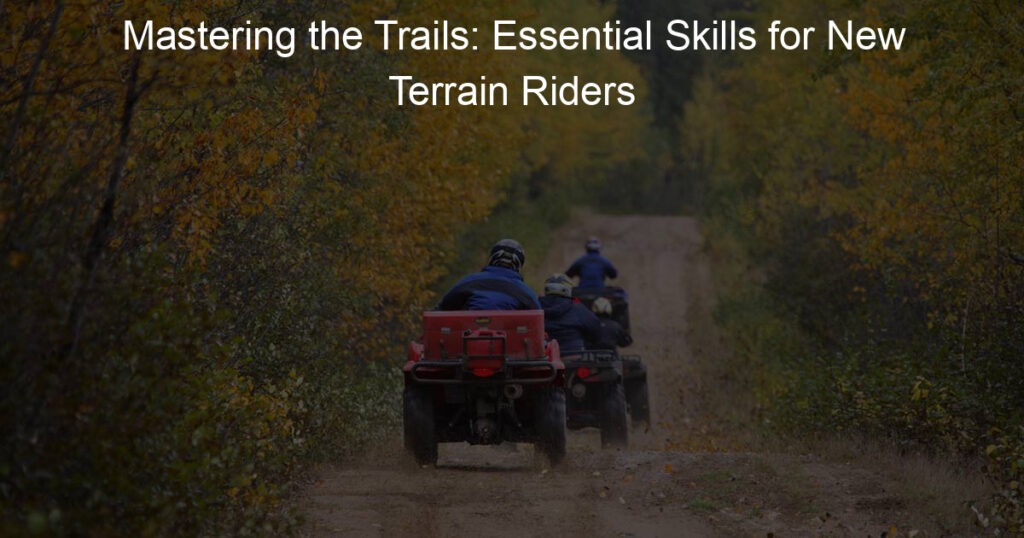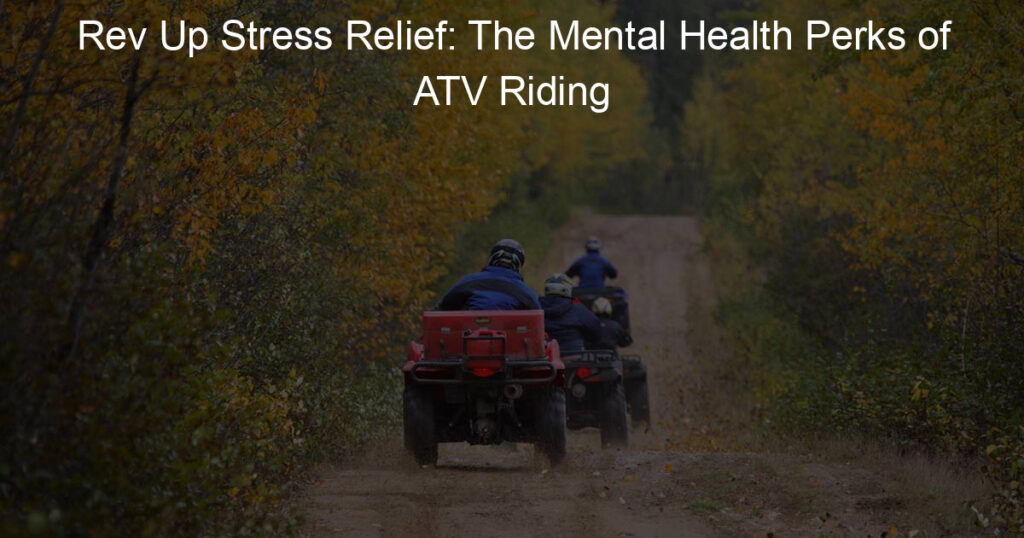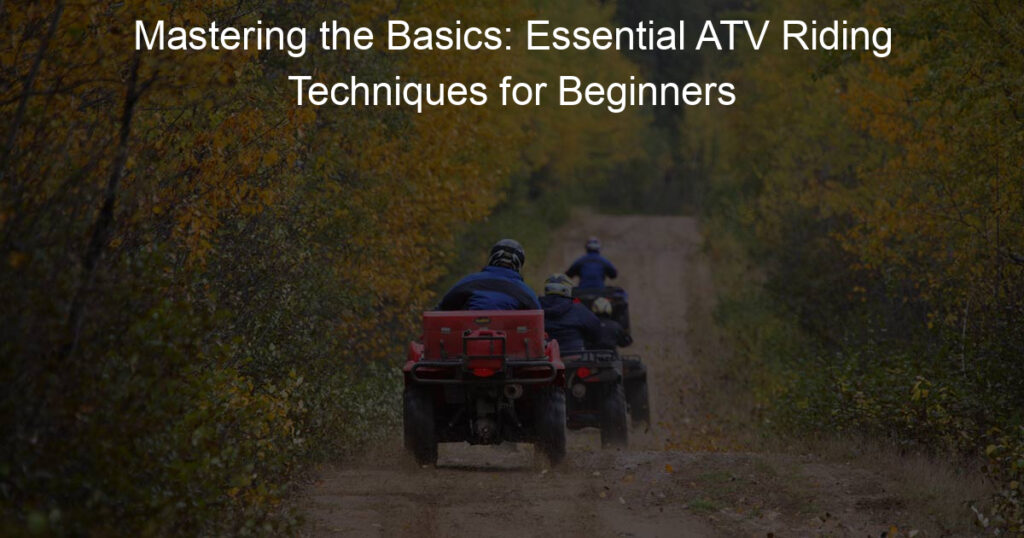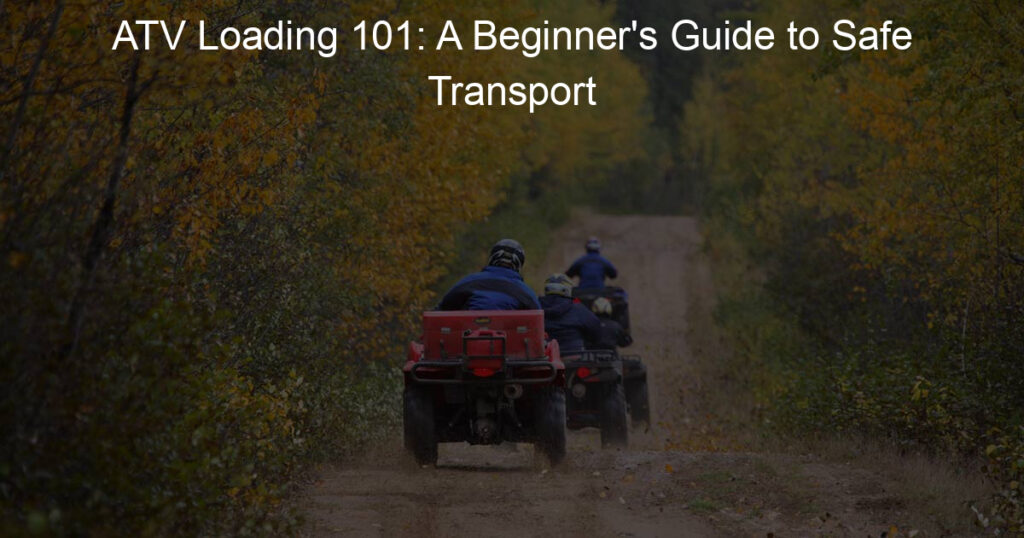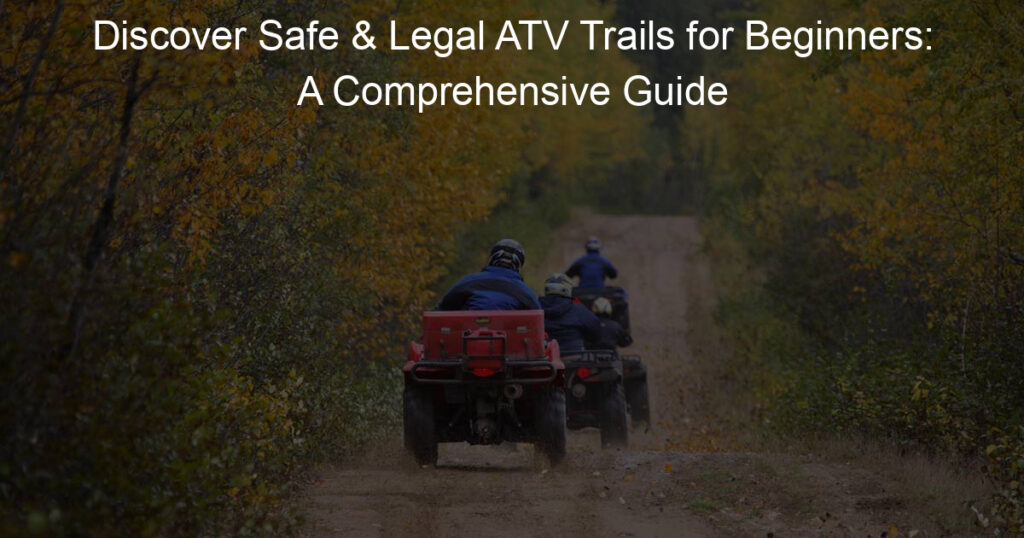Riding all-terrain vehicles (ATVs) can be an exhilarating and exciting hobby, but it’s essential to undergo proper training to ensure the safety of riders and others around them.
As a rider, I’ve come to appreciate the importance of learning about ATVs to enhance my riding experience and protect myself from potential hazards. In this article, we’ll delve into the benefits of proper ATV training and its significance.
Before taking an ATV out for a spin, it’s crucial to understand how these four-wheeled machines work, as well as the safety gear that can protect you and others.
Familiarizing yourself with ATV laws and considering factors such as different terrains, the presence of passengers, and being aware of the unique needs of children around ATVs is also necessary.
Furthermore, by enrolling in an ATV training course, you ensure that the right knowledge and skills are applied during your rides.
Key Takeaways
- Proper ATV training promotes the safety and well-being of riders and others around them.
- Training enhances the riding experience, teaching crucial aspects such as laws, safety gear, and different terrains.
- ATV courses cater to unique situations, such as riding with passengers, children’s involvement, and proper maintenance.
Basics of ATV
ATV vs UTV
As an enthusiast of all-terrain vehicles (ATVs), I’ve noticed that many people tend to confuse ATVs with utility terrain vehicles (UTVs). Both ATVs and UTVs are off-highway vehicles (OHVs) used for various recreational and utility purposes.
Nevertheless, there are some key differences between them.
ATVs are typically smaller, with a straddle seating position and a handlebar for steering. They are designed for single riders, although some models can accommodate a passenger.
On the other hand, UTVs have a side-by-side seating configuration, a steering wheel, and often a cargo bed. UTVs accommodate two to six passengers, making them suitable for larger groups.
All About OHVs
Off-highway vehicles (OHVs) are a broad category of motorized vehicles specifically designed for off-road use.
ATVs and UTVs fall under this category, but it also includes other vehicles, such as dirt bikes and snowmobiles.
- Motocross bikes: These are designed for high-speed off-road racing on rough terrain.
- Enduro bikes: Built to handle a wide range of terrain and endure long-distance off-road rides.
- Trial bikes: Designed for slow-speed maneuvers and obstacle courses.
- Snowmobiles (sleds): Engine-powered sleds with skis and a track, primarily for winter use.
OHVs are subject to different regulations and restrictions depending on where they are being operated.
Some areas require permits and registration, while others might have specific trails designated for OHV use.
ATV Functions
ATVs are versatile machines, allowing me to engage in various recreational and utility activities.
Here are some examples:
- Trail riding: Exploring designated ATV trails, usually in forests or other natural settings.
- Mudding: Riding in muddy, wet terrains – a thrilling experience for many ATV lovers.
- Hunting and fishing: ATVs can be used to access remote hunting and fishing areas.
- Racing: ATV racing events are held for different classes and age groups, from amateur to professional levels.
For utility purposes, ATVs are often equipped with accessories and attachments:
- Cargo racks and storage boxes: Useful for carrying tools, equipment, or camping supplies.
- Plows: An ATV equipped with a plow can be a practical snow removal tool.
- Agricultural attachments: Used for various farming tasks, such as tilling, planting, and seeding.
Ultimately, the diversity of ATV functions and capabilities make them a valuable vehicle for enthusiasts like me, from recreation to more practical applications.
Importance of ATV Safety
Statistical Report
In recent years, ATV safety has become a vital topic for discussion. My research shows that a significant number of accidents and injuries related to ATVs occur each year.
According to the Consumer Product Safety Commission (CPSC), there were an estimated 93,800 ATV-related emergency department-treated injuries in 2017. Among them, approximately 26% occurred in children younger than 16 years old.
These statistics highlight the importance of proper safety knowledge and practices for ATV riders. By implementing safety measures and being aware of the potential dangers, we can lower the risks associated with ATV use.
Common Injuries
It’s crucial to understand the common injuries that can result from ATV accidents to appreciate the importance of safety measures.
Here are some frequently reported injuries:
- Head injuries: Helmets can significantly reduce the risk of head injuries, which can be life-threatening or result in long-term disabilities.
- Fractures and dislocations: Wearing proper protective gear, such as gloves, long sleeves, and long pants, can prevent or lessen the severity of injuries to extremities.
- Cuts, abrasions, and bruises: These can happen in minor accidents, but their severity can be minimized with appropriate protective clothing and gear.
As an ATV rider, it’s my responsibility to prioritize safety and encourage fellow riders to do the same.
Ensuring that we have the necessary safety knowledge and equipment can go a long way in preventing accidents and allowing us to enjoy our favorite outdoor activity with peace of mind.
Safety Gear for ATV Riding
Understanding Protective Gear
As an ATV rider, I know how essential proper safety gear is in ensuring a safe and enjoyable ride. Protective gear plays a vital role in reducing the risk of injury during accidents or unexpected situations.
It’s always better to be prepared with the right gear, as it not only protects the body but also provides comfort during the ride.
Essential Safety Gear
When it comes to essential safety gear, here are some items that I never ride without:
- Helmet: A helmet protects my head from severe injuries during accidents. It’s arguably the most important piece of safety gear. I always choose a helmet that meets the Department of Transportation (DOT) standards.
- Boots: Sturdy boots with good traction protect my feet and ankles and provide stability while riding. I prefer boots specifically designed for ATV riding with added protection for ankles and extra grip on the soles.
- Gloves: I wear gloves to ensure a better grip on the handlebars and to protect my hands from abrasions, cold weather, and debris.
- Long pants: Long pants shield my legs from rocks, branches, and other debris that might hit me during the ride. I opt for sturdy materials such as denim or leather.
- Long-sleeved shirt: A long-sleeved shirt provides protection for my arms from scratches, sunburn, and debris.
- Goggles: Eye protection is absolutely crucial. Wearing goggles not only protects my eyes from dirt, dust, and flying debris but also helps improve visibility while riding.
By using the safety gear mentioned above, I am well-prepared for a safe and enjoyable ATV ride.
Remember, safety should always come first, and investing in the right gear can make all the difference during any off-road adventure.
Understanding ATV Laws
ATV Laws in Pennsylvania
In Pennsylvania, I’ve learned that it’s crucial to comply with the state’s ATV laws to ensure a safe and legal ride.
A few key points I’ve found are:
- Riders under 16 must possess a safety certificate and be supervised by an adult who also holds a safety certificate.
- All riders must wear a helmet, except for those on private property.
- ATVs must have working headlights and taillights during operation between sunset and sunrise.
- ATVs must be registered with the Department of Conservation and Natural Resources (DCNR), unless used solely on private property.
ATV Laws in California
In California, I discovered that the state has its own set of ATV laws and regulations, including:
- All ATVs must be titled and registered with the California Department of Motor Vehicles (DMV). A Green Sticker or Red Sticker is required, depending on the vehicle’s emission standards.
- Riders under 18 must wear a helmet when operating an ATV.
- Riders under 14 must be supervised by a parent or guardian.
- All ATVs must have a working horn, muffler, spark arrester, headlight, taillight, and brake light.
By understanding and adhering to these laws in both Pennsylvania and California, I ensure my safety and the safety of those around me while enjoying my ATV adventures.
Benefits of ATV Training
Online Training vs Hands-On Training
When it comes to ATV training, there is often a debate between online training and hands-on training. While online training can help you learn essential rules and regulations, I believe hands-on training provides a more immersive learning experience.
The ATV RiderCourse is a fantastic option that combines both safety education and proper riding techniques. By participating in hands-on training, I have the opportunity to practice my skills on an ATV in a controlled environment.
The benefits of hands-on training are many. For one, it allows me to perfect my riding skills under the guidance of experienced instructors. I learned how to safely navigate different terrains, effectively use my body to maintain balance, and understand the importance of keeping a proper riding posture.
Interactive Learning Experience
An interactive learning experience is essential when learning proper ATV training techniques. During the ATV RiderCourse, I am not only given instruction but also have the chance to practice skills in real-time with peers.
This interactive component helps me learn and improve my riding abilities by seeing the techniques in action and receiving immediate feedback from instructors.
In addition to enhancing my riding skills, proper ATV training teaches me the importance of safety.
I learned how to:
- Wear appropriate gear, such as helmets, long sleeves, and gloves
- Perform pre-ride inspections to ensure my ATV is in good working order
- Recognize and address issues while riding, including potential obstacles on trails
Through this interactive learning experience, I gained confidence in my riding abilities and learned how to safely enjoy my time on an ATV.
By investing in quality ATV training, I reduce the risks associated with improper riding techniques and help ensure a safe and enjoyable riding experience for both myself and others.
ATV Training Course
Role of ATV Safety Institute
I recently learned about the significance of the ATV Safety Institute in providing comprehensive ATV training courses. The institute plays a crucial role in ensuring that riders receive proper education on safety measures and riding techniques.
Through their ATV safety training, they cover essential aspects like pre-ride inspections, protective gear, and responsible riding practices. I believe investing in such courses is vital for both new and experienced riders.
Annual Recertification Practices
A fascinating aspect of ATV training courses is the annual recertification practices. These help riders stay up-to-date with the latest safety standards and best practices in the industry.
Regular recertification ensures that my riding skills remain sharp and that I am aware of any changes in safety regulations or advancements in ATV technology.
Finding a Licensed Instructor
To get the best ATV training, it’s crucial to find a licensed instructor. They have the experience and expertise required to teach proper riding techniques and safety measures.
I found the whole process of locating an instructor to be quite straightforward, as the ATV Safety Institute provides a comprehensive list of certified professionals in my area.
With their guidance, I have become a safer, more responsible rider, and I can confidently enjoy the thrilling experience of riding an ATV.
In conclusion, proper ATV training is an indispensable part of becoming a competent rider. The ATV Safety Institute, annual recertification practices, and finding a licensed instructor are crucial aspects of this training process.
By investing in thorough and ongoing education, I am ensuring not only my safety but also the safety of others while maximizing the enjoyment of my ATV adventures.
Pre-Ride Check
Brake and Tire Inspection
Before I set out on my ATV adventure, I always conduct a pre-ride inspection to ensure the safety and durability of my vehicle.
First, I examined the brakes and tires. For the brake inspection, I check the front and rear brake lever functionality, ensuring they’re functioning correctly, as well as brake pad thickness.
Next, I inspect my tires by looking for any signs of wear or damage, such as punctures, cuts, or bulges. I also carefully check the tire pressure with a reliable gauge to ensure it is within the recommended range.
Correct tire pressure plays a crucial role in maintaining proper traction and preventing tire damage.
Checking Throttle and Lights
Another essential pre-ride inspection I never skip is examining the throttle and lights. I test the throttle to ensure it operates smoothly by quickly releasing it and observing if it snaps back into its resting position.
Moreover, I check the throttle cable for seemingly frayed sections or signs of wear, which I know can potentially cause throttle malfunction.
For the lights, I make sure the main headlights, taillights, and brake lights are all functioning correctly, as they play a vital role in both visibility and alerting other riders of my presence.
If I notice any issues, I replace the bulbs or repair the wirings before heading out.
Further, I go over the chassis to verify that the nuts and bolts are tightened securely and that there are no cracks or damages in the frame. Performing these pre-ride inspections not only gives me peace of mind but also ensures a safe and enjoyable ATV riding experience.
ATV Maintenance
ATV Maintenance Basics
As an ATV enthusiast, I can’t stress enough the importance of proper maintenance. Keeping our ATVs in good condition is essential for both safety and performance.
Here are a few basic maintenance tasks that I always make sure to perform regularly:
- Check the oil levels: This is essential for the proper functioning of the engine. Make sure to change the oil according to the ATV’s manual.
- Inspect the tires: Look for signs of wear, such as cracks or punctures. Maintaining the correct tire pressure is also important; if you’re unsure of what that should be for your ATV, refer to the manual.
- Clean the air filter: Dust and debris can clog up the air filter over time, so it’s important to regularly clean it.
- Ensure the brakes function properly: Keep an eye on the brake fluid levels and make sure that the brake pads have enough life left in them.
- Lubricate the chain and components: Apply a suitable lubricant to prevent unnecessary wear, which will keep your ATV running smoothly.
Professional ATV Maintenance
In addition to taking care of the basics myself, I always make sure to consult with a professional for regular check-ups and maintenance.
Professional ATV maintenance services include:
- Tune-ups: This can involve checking and adjusting the carburetor, inspecting the fuel system, and replacing spark plugs if necessary.
- Suspension maintenance: A professional technician will inspect the shocks, forks, and bearings while also ensuring everything is properly tightened and greased.
- Drive train maintenance: Professionals inspect and ensure that the drive belts, pulleys, and gears are functioning well.
- Battery maintenance: A check-up of the ATV’s charging system and battery can help extend the battery’s life and avoid degrading the electrical system.
Remember, a well-maintained ATV performs better, is safer, and has a longer lifespan. So, taking the time to perform these tasks or scheduling regular appointments with professionals is worth it in the long run.
Safe ATV Riding Techniques
As someone who enjoys ATV riding, I want to share some safe riding techniques to help you have a great time while minimizing the risk of accidents.
These techniques focus on turning, braking, climbing, and descending, which are crucial for maintaining control and safety while riding.
Proper Turning Techniques
When turning, proper body positioning is important. While taking a turn, I lean slightly forward and shift my body weight to the inside of the turn. This helps maintain stability and allows the ATV to move more naturally.
Additionally, it’s essential to look in the direction of the turn and keep a firm grip on the handlebars. Here are a few tips for turning:
- Slow down before entering the turn
- Gently apply the throttle during the turn
- Keep a steady hand on the handlebars and steer smoothly
Braking Techniques
Understanding how to brake effectively is key to safe ATV riding.
First, always use both front and rear brakes together, as it allows for more balanced and effective stopping. I also make it a point to never lock the brakes, as it can cause a loss of steering control.
When braking on a descent, it’s important to smoothly apply pressure to both the front and rear brakes while maintaining an upright body position. Similarly, while climbing, applying slight pressure to the throttle and gradually braking can prevent the ATV from rolling backward or tipping over.
Remember to practice these techniques regularly so they become second nature, and always ride within your limits. By doing so, you’ll be able to enjoy your ATV adventures safely and responsibly.
Special Considerations for Different Terrains
ATV Riding in Water
When I ride my ATV in water, I always take extra precautions to ensure my safety. First and foremost, I always check the depth of the water before entering. Riding through water that is too deep can damage my ATV, compromise its performance, and pose a hazard to my safety.
I make sure my ATV is equipped with a snorkel to help protect the engine from water damage.
Also, I wear waterproof gear to keep myself dry and comfortable. This includes a good pair of waterproof boots to ensure stable footing when navigating the muddy or slippery terrains.
Lastly, I always go at a slow and steady pace when riding in water, as sudden acceleration can cause a loss of control.
ATV Riding in Ranches/Farms
Riding an ATV on ranches and farms requires a different set of considerations for ensuring both my safety and the well-being of the property and animals. Before I start, I always ask the property owner for any specific rules or guidelines they would like me to follow.
One key factor to consider when riding on ranches and farms is respecting the terrain. I avoid riding too close to crops, livestock, or structures, as this could damage the property and endanger the animals.
Additionally, I make sure to maintain a reasonable speed while riding, as high speeds can cause unnecessary wear on the terrain and potentially scare the animals.
When navigating through different terrains, it’s vital to adjust my riding techniques accordingly.
By keeping these special considerations in mind, I make sure to have a safe and enjoyable ATV riding experience while also respecting the environment and those around me.
Riding ATVs with Passengers
As someone who loves off-roading, I understand the importance of proper ATV training, especially when it comes to riding with passengers.
In this section, we’ll discuss ATV passenger safety to ensure a fun and secure experience for everyone involved.
ATV Passenger Safety
When I have a passenger on board, I make sure to follow these guidelines:
- Choose the right ATV: Not all ATVs are designed to carry passengers. I always check the owner’s manual to determine if my ATV is appropriate for two riders. If not, I opt for a dedicated two-up ATV with a longer wheelbase and additional seating.
- Wear proper gear: Just like me, my passenger needs to wear appropriate protective gear, including helmets, gloves, goggles, long sleeves, and pants. Comfortable and snug-fitting gear plays a crucial role in keeping everyone safe during the ride.
- Adjust riding technique: I adjust my riding style to accommodate my passenger. This means taking turns more slowly, maintaining a steady speed, and allowing for extra stopping distance. I communicate openly with my passenger about how to shift their weight during turns and when to brace for bumps and jumps.
- Limit tricks and stunts: Even if I’m skilled at performing tricks when I have a passenger, I keep the ride simple and straightforward. Stunts increase the risk of injury for both of us, and it’s better to prioritize safety over showmanship.
By keeping these important tips in mind, my passengers and I can enjoy thrilling ATV adventures together while staying safe. Happy riding!
Children and ATVs
Choosing ATVs for Children
When it comes to children and ATVs, safety is a top priority. The first step in ensuring this is selecting the right ATV for their age and size. Many manufacturers provide minimum age recommendations for their vehicles.
As a rule of thumb, I make sure to choose an ATV with an engine size of 50 to 90cc for children under 16. Smaller-engine ATVs are more manageable for them, reducing the risks of accidents.
When selecting an ATV, I always consider my child’s physical abilities and coordination. I make sure the seat is the right height and that they can easily reach the handlebars, throttle, and brake lever.
It’s important for children to have control over their vehicles for their safety.
Supervising Children While Riding
As a parent, my responsibility doesn’t end with choosing the right ATV for my child. Supervising them while riding is crucial. I ensure that my child is wearing appropriate safety gear, such as a helmet, goggles, gloves, and over-the-ankle boots.
I also make it a point to teach them basic hand signals and the importance of staying on designated ATV trails.
When my child is riding, I maintain direct supervision to monitor their progress and intervene if necessary. I also set clear boundaries on where they can ride and how fast they can go.
Establishing these guidelines helps instill responsible riding habits and emphasizes the importance of safety.
Encouraging proper ATV training ensures that children not only enjoy their outdoor adventures but also develop responsible riding habits for a lifetime.
Conclusion
I believe that proper ATV training is essential for ensuring the safe and responsible use of these vehicles. Participating in a training program can not only improve my performance but also significantly reduce the risk of accidents and injuries.
During my training, I’ll learn how to handle different terrains, navigate obstacles, and maintain my ATV in good working condition. This knowledge will enable me to make the most of my off-road adventures while staying safe and respecting the environment.
In conclusion, investing time and effort into proper ATV training benefits not only myself but also other riders and the community as a whole. By promoting safety, responsibility, and enjoyment, I can contribute to the overall positive image of ATV enthusiasts.
So, let’s all make a commitment to being well-trained riders and advocates for responsible ATV use.
Frequently Asked Questions
What are key safety tips for ATV riding?
As an ATV rider, I always ensure my safety and the safety of others by following these tips:
- Wear a helmet, goggles, long sleeves, long pants, gloves, and over-the-ankle boots.
- Inspect my ATV before each ride to check for any issues.
- Always ride at a safe speed, avoiding excessive speeds or stunts.
- Stay on designated trails and respect the environment.
- Ride with a buddy, but always maintain a safe distance.
- Avoid riding on paved roads, as ATVs are designed for off-road use.
Where can I find an ATV training course?
I found my ATV training course by searching online for certified ATV safety courses in my area. Local ATV dealers and clubs may also offer training courses or be able to provide information on upcoming courses.
Another great resource is the ATV Safety Institute (ASI), which provides a list of ASI-certified training courses across the United States.
Are there online ATV safety courses available?
Yes, there are online ATV safety courses available. The ASI offers a free online e-course that covers basic ATV safety principles. Nonetheless, I recommend taking an in-person training course to gain hands-on experience and learn from an experienced instructor.
How can I improve my ATV braking techniques?
Improving ATV braking techniques requires practice and understanding of your ATV’s braking system. I learned to assess terrain and conditions, smoothly apply both front and rear brakes, and avoid locking the wheels.
Defensive riding techniques, such as anticipating obstacles and adjusting speed accordingly, also help ensure effective braking.
What is ASI ATV training?
ASI, the ATV Safety Institute, offers ATV training courses that cover essential safety topics and hands-on riding skills. As a participant, I learned proper riding techniques, risk management, environmental responsibility, and laws related to ATV riding.
The ASI courses are designed for people of all ages and skill levels.
What are the guidelines for carrying passengers on an ATV?
For my safety and the safety of my passengers, I follow these guidelines:
- Choose an ATV specifically designed for passengers with a dedicated seat, footrests, and handholds.
- Ensure that my passenger is wearing appropriate protective gear.
- Communicate with my passenger, explaining how to hold on, shift weight, and lean into turns.
- Ride at a slower pace and on familiar terrain to accommodate the extra weight and balance requirements.
- Avoid steep hills, sharp turns, and other challenging obstacles when carrying a passenger.
